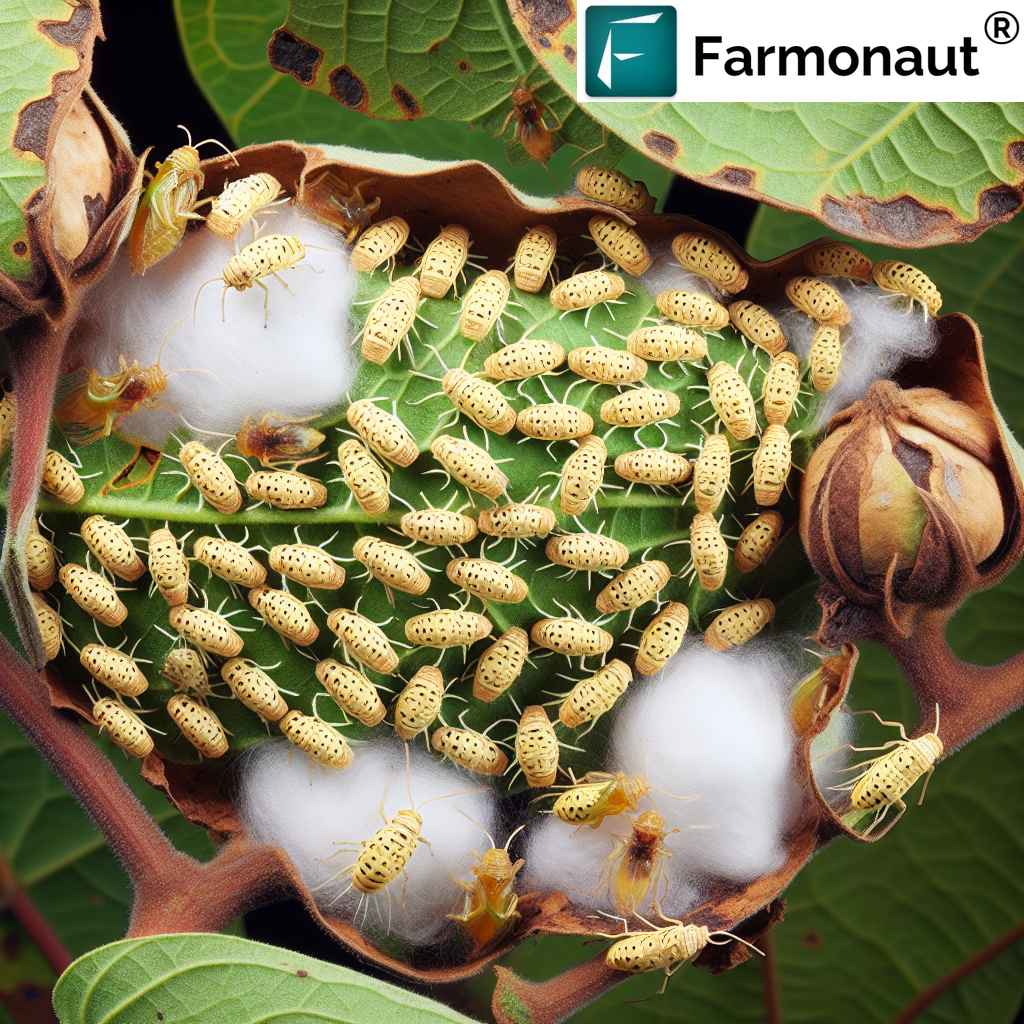Combating Cotton Jassid Damage: Expert Tips to Protect Your Crop Yield

As agricultural technology experts at Farmonaut, we understand the critical challenges farmers face in protecting their cotton crops from pests. One of the most significant threats to cotton production is the jassid, a small but destructive insect that can cause severe damage to cotton plants. In this comprehensive guide, we’ll explore the intricacies of cotton jassid damage, its impact on crop yields, and provide expert tips on how to effectively combat this pest using modern agricultural technologies and traditional methods.
Understanding Cotton Jassid and Its Impact
The cotton jassid, scientifically known as Amrasca biguttula biguttula, is a major pest that affects cotton crops worldwide. These tiny, wedge-shaped insects feed on the sap of cotton leaves, leading to a condition known as “hopper burn.” Jassid damage in cotton can result in significant economic losses for farmers if not addressed promptly and effectively.
Identifying Jassid Damage
Recognizing the signs of jassid damage is crucial for early intervention. Here are some key indicators:
- Yellowing of leaf margins, which gradually turns brown
- Curling and crinkling of leaves
- Stunted plant growth
- Reduced flower and boll formation
- In severe cases, complete defoliation of the plant

The Economic Impact of Jassid Infestation
The economic consequences of cotton jassid damage can be severe. Studies have shown that jassid infestations can lead to yield losses of up to 40% in severe cases. This translates to significant financial setbacks for farmers and can have ripple effects throughout the cotton industry supply chain.
Leveraging Technology to Combat Jassid Damage
At Farmonaut, we believe in harnessing the power of technology to address agricultural challenges. Our satellite-based crop monitoring system offers farmers a cutting-edge solution to detect and manage jassid damage in cotton fields efficiently.
Satellite Imagery for Early Detection
Our advanced satellite imagery technology allows farmers to monitor their cotton fields remotely. By analyzing multispectral data, we can detect changes in crop health that may indicate jassid infestation before visible symptoms appear. This early warning system enables farmers to take prompt action, potentially saving their crops from severe damage.
AI-Powered Advisory System
Farmonaut’s Jeevn AI advisory system integrates satellite data with machine learning algorithms to provide personalized recommendations for pest management. By analyzing historical data, weather patterns, and current field conditions, our AI can suggest optimal timing and methods for jassid control measures.
Why Farmonaut’s Satellite System Outperforms Drones and IoT
| Feature | Farmonaut Satellite System | Drone-based Monitoring | IoT Sensors |
|---|---|---|---|
| Coverage Area | Large scale (thousands of hectares) | Limited (few hectares per flight) | Localized (point data) |
| Frequency of Data Collection | Regular (every 3-5 days) | On-demand (requires manual flights) | Continuous but limited to sensor locations |
| Cost-effectiveness | High (no hardware investment) | Moderate (requires drone purchase and operation) | Low (high initial investment in sensors) |
| Data Processing | Automated with AI integration | Often requires manual processing | Automated but limited to sensor data |
| Weather Independence | High (can capture data through clouds) | Low (affected by wind and rain) | Moderate (can be affected by extreme conditions) |
To start leveraging these advanced technologies for your cotton farm, visit Farmonaut’s application or explore our API services for integration with your existing systems.
Traditional Methods for Jassid Control
While technology plays a crucial role in modern agriculture, traditional pest control methods remain valuable, especially when integrated with advanced monitoring systems. Here are some proven strategies for managing cotton jassid damage:
- Crop Rotation: Implementing a crop rotation system can disrupt the jassid life cycle and reduce population buildup.
- Resistant Varieties: Planting cotton varieties with hairy leaves can deter jassids from feeding and laying eggs.
- Intercropping: Growing compatible crops alongside cotton can create a less favorable environment for jassids.
- Biological Control: Encouraging natural predators like ladybirds and lacewings can help keep jassid populations in check.
- Neem-based Insecticides: Organic neem oil sprays can be effective against jassids while being environmentally friendly.
Integrated Pest Management (IPM) for Jassid Control
At Farmonaut, we advocate for an Integrated Pest Management (IPM) approach that combines technological solutions with traditional methods. This holistic strategy not only addresses cotton jassid damage but also promotes sustainable farming practices.
Key Components of IPM for Jassid Control:
- Regular monitoring using satellite imagery and ground-level inspections
- Establishing economic thresholds for intervention
- Utilizing biological control agents
- Implementing cultural practices like proper spacing and timely irrigation
- Judicious use of chemical controls when necessary
By adopting an IPM approach, farmers can effectively manage jassid populations while minimizing environmental impact and preserving beneficial insects.
The Role of Weather in Jassid Infestations
Weather conditions play a significant role in jassid population dynamics and the severity of jassid damage in cotton. Farmonaut’s weather API provides crucial data that helps farmers anticipate and prepare for potential jassid outbreaks.
Key Weather Factors Affecting Jassid Populations:
- Temperature: Warm temperatures accelerate jassid reproduction
- Humidity: High humidity favors jassid survival and reproduction
- Rainfall: Excessive rain can wash away jassids, but also create favorable conditions for population growth
By integrating weather data with our satellite imagery, Farmonaut provides farmers with a comprehensive tool for predicting and managing jassid infestations. To access our weather API and developer documentation, visit Farmonaut’s API Documentation.
Case Studies: Successful Jassid Management with Farmonaut
While we don’t include specific case studies in this blog, it’s worth noting that numerous cotton farmers across various regions have successfully utilized Farmonaut’s technology to combat cotton jassid damage. These success stories demonstrate the effectiveness of combining satellite monitoring with traditional pest management strategies.
The Future of Jassid Control in Cotton Farming
As agricultural technology continues to evolve, we at Farmonaut are committed to staying at the forefront of innovation in pest management. Future developments in satellite technology, AI, and precision agriculture promise even more effective tools for combating jassid damage in cotton.
Emerging Technologies in Jassid Control:
- Hyperspectral imaging for earlier detection of stress signals
- Advanced AI models for predicting pest outbreaks
- Precision application of biopesticides using drone technology
- Gene editing for developing more resistant cotton varieties
Stay updated on these advancements by following Farmonaut on our mobile apps:
Android App
iOS App
Conclusion
Managing cotton jassid damage requires a multi-faceted approach that combines cutting-edge technology with time-tested agricultural practices. By leveraging Farmonaut’s satellite-based monitoring system, AI-powered advisory services, and integrating these with traditional pest control methods, farmers can significantly reduce the impact of jassid infestations on their cotton crops.
Remember, early detection and prompt action are key to preventing severe jassid damage in cotton. With Farmonaut’s comprehensive suite of tools, farmers are better equipped than ever to protect their crops and ensure healthy yields.
FAQ Section
Q1: How often should I monitor my cotton fields for jassid damage?
A1: We recommend regular monitoring, ideally every 3-5 days using Farmonaut’s satellite imagery. Additionally, conduct weekly ground-level inspections to complement satellite data.
Q2: Can organic farming methods effectively control jassid populations?
A2: Yes, organic methods like neem-based sprays, intercropping, and encouraging natural predators can be effective when combined with proper monitoring and timely application.
Q3: How does Farmonaut’s technology help in early detection of jassid infestations?
A3: Our satellite imagery can detect subtle changes in plant health before visible symptoms appear, allowing for early intervention. The AI system analyzes this data to provide timely alerts and recommendations.
Q4: Are there any resistant cotton varieties that can withstand jassid attacks?
A4: Yes, several cotton varieties with hairy leaves or other resistant traits have been developed. Consult with local agricultural experts or use Farmonaut’s advisory system for recommendations suited to your region.
Q5: How can I integrate Farmonaut’s technology into my existing farm management practices?
A5: Farmonaut offers flexible solutions that can be integrated via our mobile apps or API services. Visit our website or contact our support team for personalized assistance in implementing our technology on your farm.
Subscribe to Farmonaut
Ready to take your cotton farming to the next level? Subscribe to Farmonaut’s services and gain access to our advanced satellite monitoring and AI-powered advisory system.
By subscribing, you’ll join a community of forward-thinking farmers who are leveraging technology to combat pests like jassids and optimize their crop yields. Don’t let cotton jassid damage impact your bottom line – take control with Farmonaut today!

